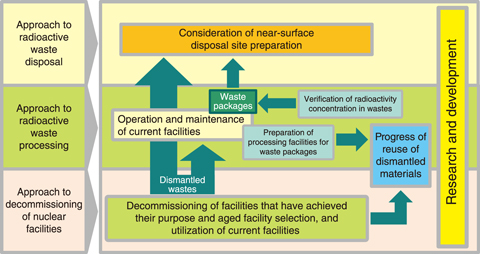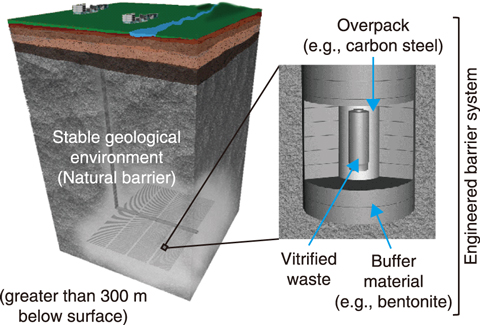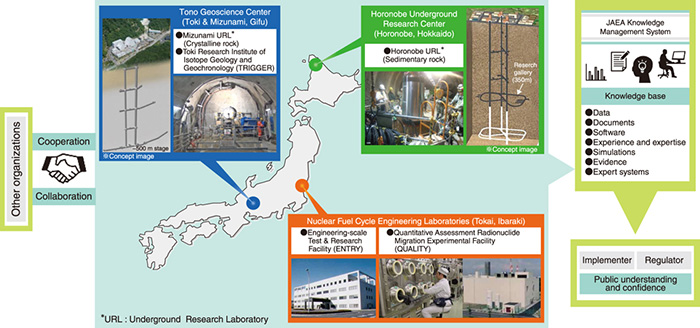
Fig.8-1 Outline of low-level radioactive waste management

Fig.8-2 Schematic of the geological disposal concept for high-level radioactive waste in Japan

Fig.8-3 Structure of JAEA R&D activities
Toward Decommissioning of Nuclear Facilities and Radioactive Waste Management
To maintain and develop its R&D capabilities by strengthening the safety of its nuclear facilities and ensure steady implementation of back-end measures, JAEA formulated the “Medium- and Long-Term Management Plan of our Facilities” (issued on April 1, 2017, amended on April 1, 2019) as a comprehensive plan which detailed the following three points:
• the selection and consolidation of facilities,
• safety measures, and
• management of back-end issue.
In the plan, 89 nuclear facilities were chosen to be decommissioned.
JAEA submitted an application for permission to proceed with the decommissioning of MONJU and the Tokai Reprocess-ing Plant (TRP) to the Nuclear Regulation Authority (NRA), which led to NRA granting this permission for MONJU on March 28, 2018 and for TRP on June 13, 2018.
Implementation of back-end measures requires long-term prospects and policies, including regarding the processing and disposal of radioactive waste; the decommissioning of TRP has been expected to take approximately 70 years to complete. JAEA therefore published a long-term prospect and policy for back-end measures, i.e., the “Back-end Roadmap”, on December 26, 2018.
To ensure a safe and appropriate nuclear facility decommissioning and radioactive waste management, it is necessary to introduce new technologies and knowledge and to promote the development of technologies for advanced safety and cost reduction. We have been comprehensively developing technologies for the safe and effective dismantling of nuclear facilities, minimization and stabilization processing of radioactive wastes, and the disposal of radioactive wastes (Fig.8-1). The proposed disposal project will be able to be applied to low-level radioactive wastes from research facilities of universities and private organizations as well as our own.
Specifically, this year saw the development of an analytical method of uranyl ions in radioactive wastes (Topic 8-1), a proposed decontamination technology for radioactive wastes (Topic 8-2), a study on the stability of disposal procedures of radioactive wastes (Topic 8-3), and a study on the reclamation of Ningyo-Toge uranium mines (Topic 8-4).
R&D to Improve Technology and Reliability of Geological Disposal in Japan
Geological disposal is internationally recognized as the most appropriate method for the long-term isolation of high-level radioactive waste (HLW) produced during the generation of nuclear power from human environments. This is a critical issue which the present generation must approach sensibly and will remain as such, regardless of any revision to the national nuclear energy policy.
In Japan, fuel spent in power reactors is reprocessed to extract the reusable uranium and plutonium for power generation. The liquids separated from the spent fuel during chemical reprocessing are solidified into a stable glass form. Under the Japanese disposal concept, vitrified waste is encapsulated in a thick steel overpack, surrounded by highly compact bentonite, and placed in a stable geological environment at a depth of more than 300 m below ground (Fig.8-2).
Implementing geological disposal methods of HLW is a long-term project that will last over 100 years. The project begins with the site selection and continues with the repository construction and operation, which is followed by backfill for repository closure. It is a national responsibility and of great importance to proceed efficiently with the project, continuously improving its sound technical basis and applying these attitudes to its implementation, regulatory activities, and to the enhancement of public confidence. To improve the technologies used for reliable geological disposal in Japan, progress in the R&D in various fields such as geoscience, repository engineering, and safety assessment have and will continue to be of the utmost priority (Fig.8-3).
Underground Scientific Research
Research has centered around projects at two underground research laboratories (URLs), including the examination of crystalline rocks at Mizunami and of sedimentary formations at Horonobe (Topics 8-5 and 8-6, respectively).
To evaluate the long-term stability of geological environments in Japan, studies on topics such as tectonics, volcanic and faulting activities, and dating techniques are currently in progress at the Toki Geochronology Research Laboratory (TGR) (Topics 8-7 and 8-8).
R&D of Geological Disposal Technologies
Together with the above-mentioned geoscientific efforts, an extensive study to assess the performance of the disposal system, engineered barrier systems, and long-term chemistry and migration of radionuclides at Tokai (Topics 8-9 and 8-10) are being performed. These studies have exploited the data and information on geological environments that were obtained through geoscientific research at the mentioned URLs.
Results of these activities have been summarized as a web-based report (CoolRep) on JAEA’s public website (CoolRep: https://kms1.jaea.go.jp/CoolRep/english.html).
Improving the Safety of the TRP and Developing Decommissioning Technologies
The decommissioning plan for the Tokai Reprocessing Plant (TRP) received approval from the Nuclear Regulation Authority (NRA) in June 2018, entering the TRP into a new stage of decommissioning. The vitrification of high-level radioactive liquid waste has been conducted with primary focuses on safety and on the risk reduction of the radioactive material stored as a solution. Advanced vitrification technologies have been developed and vitrification of the high-level radioactive liquid waste is scheduled to be completed by the 2028 Japanese fiscal year.
Cementation technologies of the low-level radioactive liquid waste have been developed. However, if low-level radioactive liquid waste is solidified directly, bringing the solidified waste into a disposal site may be restricted, since nitrates have been designated as an environmentally regulated substance for near-surface disposal. As such, installation of a new equipment that the nitrate is replaced with carbonate has been decided, and a new cement material suitable for carbonate, blast furnace slag fine powder (BFS), has been selected. Drum scale solidification tests confirmed that the solidified samples satisfied compressive strength requirements (Topic 8-11).
Additionally, the reprocessing adaptability of new fuel cladding tube material has been studied to prevent severe accidents in the nuclear reactor (Topic 8-12), and the flow in a centrifugal contactor has been studied to predict the extraction of uranium and plutonium (Topic 8-13).